Cozumel Turtle Trivia
Cozumel Turtle Trivia: Turtles Hone in On Their Nesting Areas
Biol. Carlos Ricardo Peralta M discusses this interesting trait ….
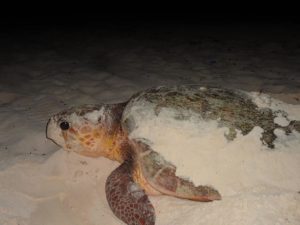
Did you know?
That Sea Turtles returns to the same beaches they were born?
This behavior is known as Philopatry, from the greek roots Phylo = affection, Patra = fatherland literally “home loving”.
There are different types of this behavior but the one that the sea turtles have is Natal Philopatry or Natal Homing.
There are several different kinds of marine animals that demonstrate natal homing. The most commonly known is the sea turtle. Loggerhead sea turtles (Caretta caretta) are thought to show two different types of homing. The first of which comes in the early stages of life. When first heading out to sea, the animals are carried out by tides and currents with little swimming involved. Recent studies now show that the animals demonstrate homing to feeding grounds near their natal birthplace.
Turtles of a specific natal beach show differences in their mitochondrial DNA haplotypes that distinguish them from turtles of other nesting areas. Many turtles from the same beaches show up at the same feeding areas. Once reaching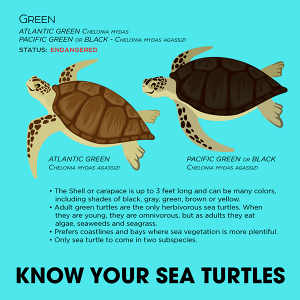 sexual maturity in the Atlantic Oceans, the female Loggerhead makes the long trip back to her natal beach to lay her eggs. The Loggerhead sea turtle in the North Atlantic cover more than 9,000 miles round trip to lay eggs on the North American shore.
sexual maturity in the Atlantic Oceans, the female Loggerhead makes the long trip back to her natal beach to lay her eggs. The Loggerhead sea turtle in the North Atlantic cover more than 9,000 miles round trip to lay eggs on the North American shore.
The exact causes for the evolution of natal philopatry are unknown. One hypothesis proposed by William M. Shields on his book Philopatry, inbreeding, and the evolution of sex suggested that philopatry was a way of ensuring inbreeding, he argued that, since philopatry leads to the concentration of related individuals in their birth areas, which in turn seems to benefit the protection of a local gene complex that is finely adapted to the local environment.
At the moment of releasing the hatchlings we try not to intervene that much in order to prevent disruption in any possible imprinting happening in this stage of life, since this phenomenon isn’t fully understood yet. But something for sure is that we make sure to help the sea turtles to have a good start.
sources:
http://www.unc.edu/depts/oceanweb/turtles/
Shields, W.M. (1982). Philopatry, inbreeding, and the evolution of sex. Albany (NY): State University of New York Press
Trivia-tortuga de Cozumel: las tortugas se dirigen hacia sus áreas de anidación
El biólogo Carlos Ricardo Peralta M. platica sobre esta interesante particularidad. . .
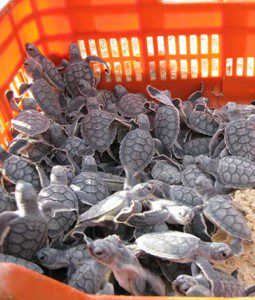
¿Sabían que…
Las tortugas marinas regresan a las mismas playas donde nacieron?
A este comportamiento se le conoce como filopatría, del griego raíces Phylo = afecto, Patra = patria, Que literalmente quiere decir “amor a su patria”.
Existen diferentes tipos de este comportamiento, pero aquel de las tortugas marinas es la filopatría natal o volver al hogar natal.
Diversos animales marinos demuestran la tendencia de volver al hogar natal. Entre éstos, el más común es la tortuga marina. Se cree que las tortugas caguama (Caretta caretta) muestran dos tipos distintos de tendencia para retornar a casa. El primero de estos llega en las etapas tempranas de la vida. Cuando por primera ocasión se dirigen hacia el mar los animales son llevados por las mareas y las corrientes implicando poco esfuerzo para nadar. Los estudios recientes muestran que los animales muestran filopatría en áreas de alimentación cercanas a sus lugares de nacimiento.
Las tortugas nacidas en una playa específica muestran diferencias en sus holotipos de ADN mitocondrial que les distingue de tortugas procedentes de otras áreas de anidación. Muchas tortugas que proceden de la misma playa, aparecen en las mismas áreas de alimentación. Una vez que llegan a la madurez sexual en el Océano Atlántico, la hembra caguama hace el largo viaje de regreso a su playa natal para colocar sus huevos. La tortuga caguama del Atlántico Norte recorre más de 9,000 millas en el viaje redondo para colocar sus huevos en las playas norteamericanas.
Se desconocen las causas exactas de la evolución de la filopatría natal. Una hipótesis propuesta por William M. Shields en
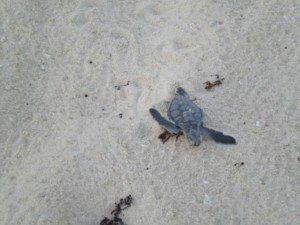
su libro Philopatry, inbreeding and the evolution of sex sugiere que la filopatría era una manera de asegurar la endogamia; enunciaba lo anterior en virtud que la filopatría conduce a la concentración de individuos relacionados en sus zonas de nacimiento, lo que a su vez parece beneficiar la protección de un complejo genético local meticulosamente adaptado al ambiente local.
Ya que este es un fenómeno que aún no se ha comprendido bien, al momento de liberar tortuguitas procuramos no intervenir lo más posible para prevenir cualquier posible rasgo que pueda estar ocurriendo en esta etapa de vida. Pero algo es sí es seguro es que nos aseguramos de ayudar a las tortugas marinas a que tengan un buen comienzo en la vida.
Fuentes:
http://www.unc.edu/depts/oceanweb/turtles/
Shields, W.M. (1982). Philopatry, inbreeding, and the evolution of sex. Albany (NY): Prensa Universidad Estatal de New York
______________________________
Una ex yanqui de Connecticut quien llama hogar a Cozumel desde hace más de 15 años. Laura escapó al Caribe hace años, desplazándose de una isla a otra dando clases de BUCEO. Se dedicó a perder el tiempo en Jamaica y finalmente se detuvo en Cozumel para pasar unas vacaciones de 2 semanas que aún no terminan. Convenciendo a sus padres que pagaran una elegante universidad privada, obtuvo su título en Periodismo y Laura crea semanalmente Cozumel 4You, medios sociales y artículos promocionales sobre la Isla y también es moderadora en el grupo Cozumel 4 You en Facebook que actualmente cuenta con 25,000 miembros. Fabián, s umuy tolerante marido, desde hace mucho tiempo se resignó a no tener vida privada, pues se ha visto implicado en los diversos proyectos y planes que urde Laura. Son orgullosos padres de diversos perros y gatos rescatados. Mientras contempla su paso a través de la vida en el Caribe mexicano,Laura continúa siendo la pesadilla en la existencia de su muy tradicional suegra mexicana.
- Living Home Cozumel Financing - July 11, 2025
- Cozumel 4 July Fundraiser Success - July 11, 2025
- July Cozumel 4 You NEWS - July 11, 2025
An ex-Connecticut Yankee who has called Cozumel home for over 18 years, Laura ran away to the Caribbean years ago, bumped around the islands teaching SCUBA diving, lost some time in Jamaica, and finally stopped in Cozumel for a 2 week vacation that hasn’t ended yet. With a degree in Journalism from a fancy private college she convinced her parents to pay for, Laura writes, edits, and creates the weekly Cozumel 4 You news, social media, and promotional articles about the island, as well as moderates the Cozumel 4 You Facebook group, which currently has over 25,000 members. Her long suffering husband, Fabian, has long since resigned himself to having zero private life, as he’s been involved in her various schemes and plots since his arrival. Proud parents to a variety of rescue dogs and cats, Laura continues to be the bane of her traditional Mexican mother-in-law’s existence, as she muses her way through life in the Mexican Caribbean. ______________________________ Una ex yanqui de Connecticut quien llama hogar a Cozumel desde hace más de 15 años. Laura escapó al Caribe hace años, desplazándose de una isla a otra dando clases de BUCEO. Se dedicó a perder el tiempo en Jamaica y finalmente se detuvo en Cozumel para pasar unas vacaciones de 2 semanas que aún no terminan. Convenciendo a sus padres que pagaran una elegante universidad privada, obtuvo su título en Periodismo y Laura crea semanalmente Cozumel 4You, medios sociales y artículos promocionales sobre la Isla y también es moderadora en el grupo Cozumel 4 You en Facebook que actualmente cuenta con 25,000 miembros. Fabián, s umuy tolerante marido, desde hace mucho tiempo se resignó a no tener vida privada, pues se ha visto implicado en los diversos proyectos y planes que urde Laura. Son orgullosos padres de diversos perros y gatos rescatados. Mientras contempla su paso a través de la vida en el Caribe mexicano, Laura continúa siendo la pesadilla en la existencia de su muy tradicional suegra mexicana.
Loggerhead Turtle Rescue Cozumel
Loggerhead Turtle Rescue Cozumel Loggerhead Turtle Rescued From Playa San Martin ...
June Hot Weather Bees Cozumel
June Hot Weather Bees Cozumel June’s Hot Weather Can Bring Out...
2025 Cozumel Caribbean Hurricane Season
2025 Cozumel Caribbean Hurricane Season 2025 Cozumel Caribbean Hurricane Season Meteorologists...
Conch Ban Season Cozumel
Conch Ban Season Cozumel Respect the “Out of Season” Conch Ban in...









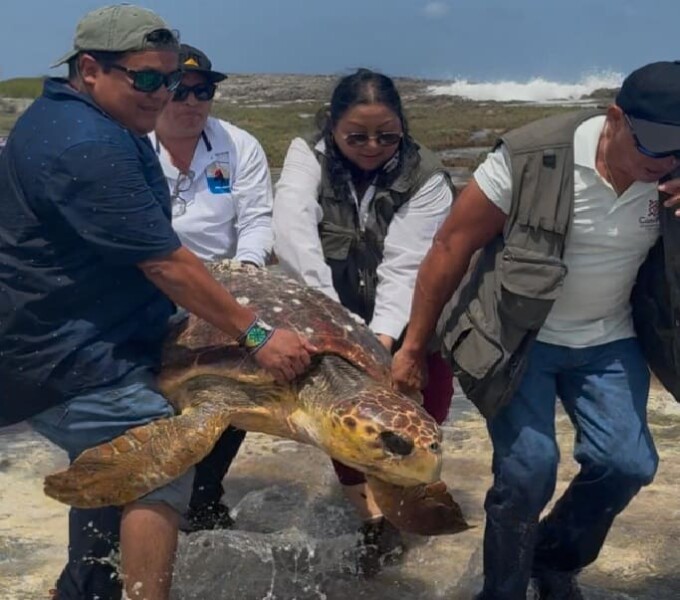

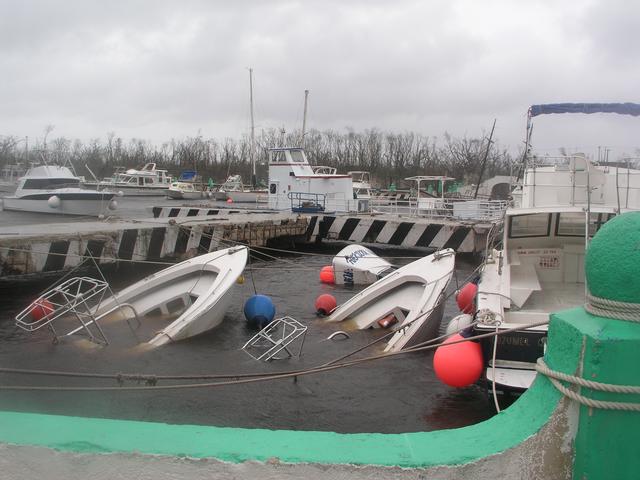
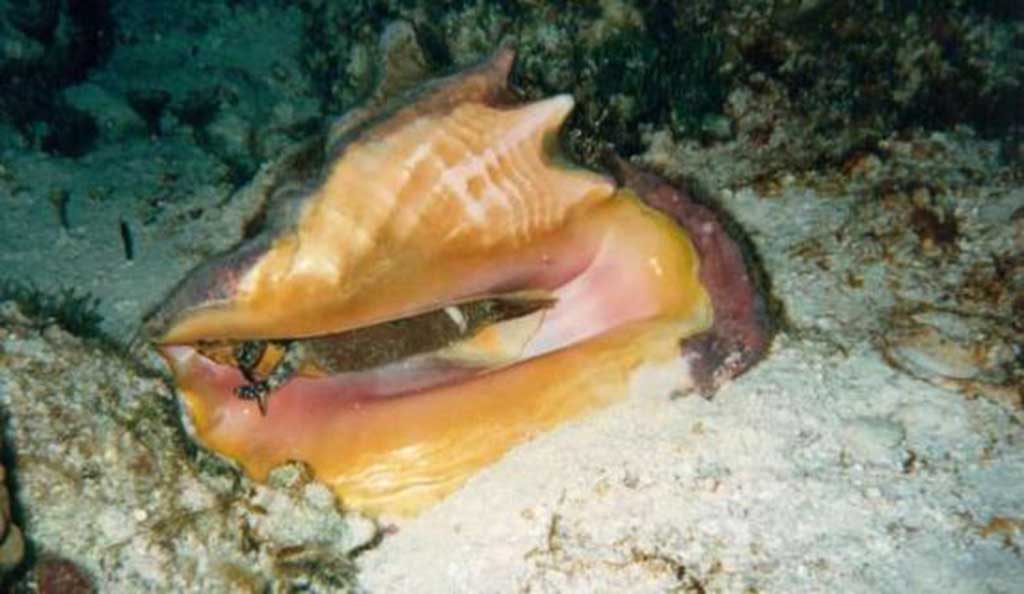







Leave a comment